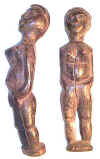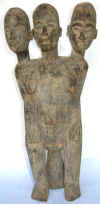 |
 |
 |
 |
TRIBAL AFRICAN ART
LOBI
Burkina Faso, Côte d'Ivoire and Ghana
The Lobi people number 160,000 to
300,000. Avoiding contact with Europeans, for a long time they escaped ethnographic
observation, and their sculpture was not completely discovered until 1950s. Very few Lobi have converted to either Christianity or Islam. Their
land is well watered and sparsely forested, with enough seasonal rainfall to grow sorghum,
millet and corn, and root crops such as yams. The men work the fields, but it is the women
who sow and carry the ears of corn in large baskets on their head. They raise cattle and
many kinds of poultry, primarily used for sacrifices and for payment of the bride price.
During the wet season when they are not in the fields, the men work
wood and iron, labor in the foundry, and build houses. The Lobi were not familiar with
centralized authority but were organized in groups of patrilineal and matrilineal clans.
They revere spirits known as thil. These
thil communicate religious laws to the community through diviners, and these laws
govern the community.
Sculptors, who live off farming, devote
only part of their time to sculpture; their period of apprenticeship may be reduced, so
that the objects are of variable quality, often quite mediocre. The Lobi do not use masks,
but create male and female spirit figures called bateba and heads sculpted on top of a post
planted in the ground. Bateba is considered as a living being and may see,
communicate, and intervene on behalf of its thil spirit. Lobi figures are
between 2” and 35” high. In every house
a small shrine room is set apart for the worship of ancestral spirits. Shrines are built to the thil spirits under the
instructions of a sorcerer and are filled with a variety of wooden
statues together with assortment of clay sculptures, iron staffs, bottles, pots and the
like. Frequent sacrifices are made at these shrines to ensure the goodwill of the
ancestors, and to avoid Illness and misfortune. The figures, associated with the dead,
are beings that are somewhere between spirits and people and may represent the dead, or
ghost, or bush spirit. The figures preside over foundation rites, essential for obtaining
protection for new homes. They were also used by
soothsayers and by the leaders of the family cult.
Large heads depicted on a post or stake form a unique category of
Lobi sculpture. Many examples are sculpted with great care and attention to detail, and,
unlike the full-bodied figures, they often show a triple scarification at the temple.
These sculpted heads were fixed into the ground at various shrines and in the open air.
They are found with their spike set into the top of an external wall, where they served as
guardians of the house.
The Lobi also produce seats with three feet, sometimes decorated with a human or animal figure. Lobi arts also include a wide variety of small human and animal images, implements, and more abstract symbols in copper alloy and iron. Some of these are worn as jewelry and some appear on shrines.